 Re: 24 lighthouses, 4 lantern rooms, 6,271 miles, $1,011 for gas, 16 day
#66134
07/06/08 01:50 AM Re: 24 lighthouses, 4 lantern rooms, 6,271 miles, $1,011 for gas, 16 day
#66134
07/06/08 01:50 AM
|
Joined: Dec 2002
Posts: 1,964
sandy
 OP
OP
Cruise Director
|
OP

Cruise Director
Joined: Dec 2002
Posts: 1,964 |
Next stop was to photograph Halfmoon Reef Light located in Port Lavaca on Highway 35. Originally located above the water of Matagorda Bay, this screwpile lighthouse consisted of a wooden, hexagonal structure, 16' on a side, surmounted by a lantern room and supported by seven 25' iron piles. The piles had threads 2' in diameter on one end to facilitate screwing the piles into the shoal to a depth of 9'. Completed in July of 1858, it had a fixed white light produced by a 6th-Order Fresnel lens. A ruby red glass chimney was used in the oil lamp to change the characteristic to red following complaints from mariners that the Matagorda Peninsula dunes would obscure the Halfmoon Reef light, creating a flashing signature like that of the nearby Matagorda Island Lighthouse. The 1942 hurricane tore the walkway from the lighthouse and left it sagging on its pilings. The Coast Guard decided to sell the structure rather than repair it. Purchased privately, it was used as living quarters for the nightwatchman of a dredging business. Thirty-six years later, it was donated to the Calhoun County Historical Commission for use as a museum. A sizeable trust fund for maintaining the structure was also provided. It was transported across the Matagorda Causeway and restored in 1979 as an Eagle Scout service project. Placed on its present piers in 1985, the porch was added, 3 flag poles were erected, and a Texas Historical Marker was unveiled at the site by the generous donors of the lighthouse. 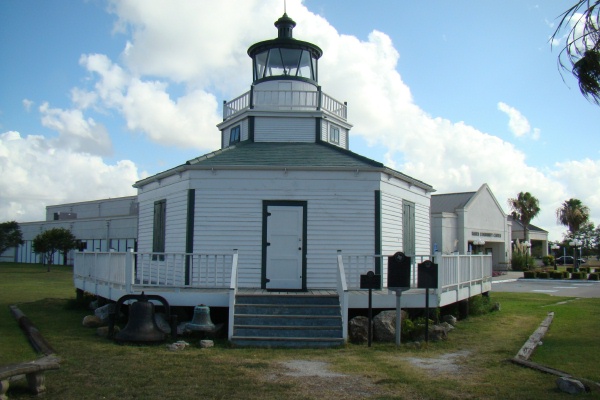 Thursday, 6/12/08, we traveled by catamaran (Capt. Bob Hill of Port O’Connor Charters) to Matagorda Island and views of Matagorda Island Lighthouse. Neither of us was up for bicycling to the station from the dock (3 miles), but Stan lamented not having done so when he saw the pictures. The array of reflecting lamps in the brick-lined 55' iron tower’s lantern room was first seen in December of 1852. A series of upgrades would occur during the next decade– distinctive daymark of alternating white, red, and black horizontal bands; a wire enclosure around the lantern room to protect the glass plates and lens from birds; additional iron sections were cast and used to raise the lantern room an additional 24' giving the conical tower its distinctive long, straight neck; a rotating 3rd-Order Fresnel lens was activated in July of 1859. Its lens was removed and crated for storage during the Civil War. Confederate soldiers were ordered to destroy the tower, but the explosive charge only succeeded in damaging 6 of the tower’s iron sections and removing a large chunk of its foundation. After the war ended in 1865, a temporary 3-story wooden tower fitted with a 5th-Order Fresnel lens was put into operation on the island to serve until the original tower was repaired. The original keeper’s dwelling did not survive the war and the keeper and his family lived in this temporary tower that leaked very badly. The encroaching surf threatened to topple the already damaged tower in 1866, so the lighthouse was disassembled and its pieces stored on one of the island’s high spots. The tower was reassembled 2 miles further inland and the lighthouse returned to service in September of 1873. It was painted solid black and outfitted with a new 3rd-Order Fresnel lens and fitted with 4 bull’s eyes. Electrified in 1956 and automated shortly thereafter, its keeper served as a civilian custodian and was assisted by 2 Coast Guardsmen. Together, they made biweekly checks of 61 beacon lights around Matagorda Bay until the custodian retired in 1965. The Fresnel lens was removed in 1977. Public protests kept the solar-powered light in service until 1995. The island is controlled by Texas Parks and Wildlife Department who maintains the land surrounding the lighthouse. Future plans call for the reconstruction of the keeper’s quarters. Its Fresnel lens can be seen at the Calhoun County Museum in Port Lavaca. 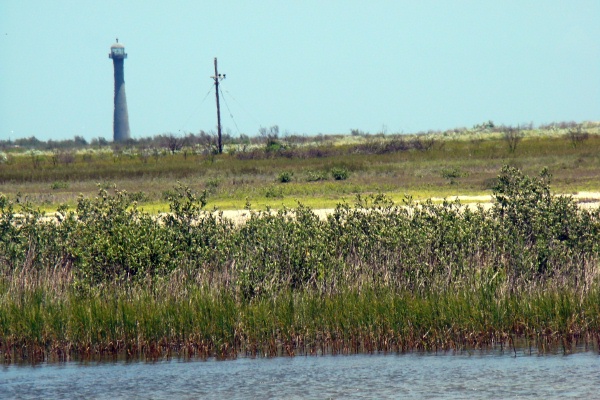 The balance of the day was going to be locating and photographing four faux lights, but we were losing steam and opted to just kick back at the Comfort Inn in Conroe, Texas. Friday found us at Brazoria County Historical Museum, Angleton, Texas. Brazos River Lighthouse, an 1896-built 96' square pyramidal skeletal tower (sibling of Sanibel Island Light, FL) was demolished in 1967. Its lantern room is on the grounds of the Museum: 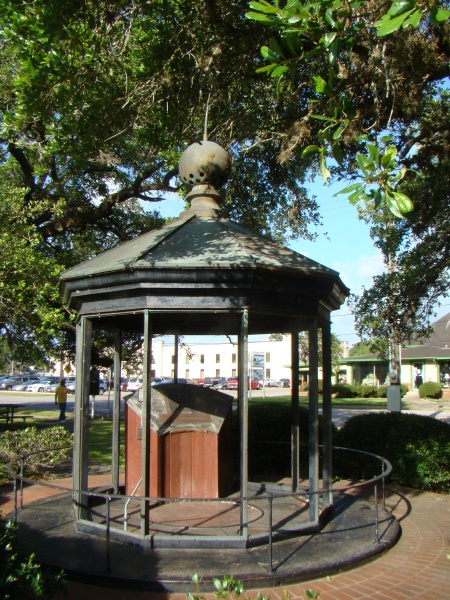 and its 3˝ -Order Fresnel lens is inside: 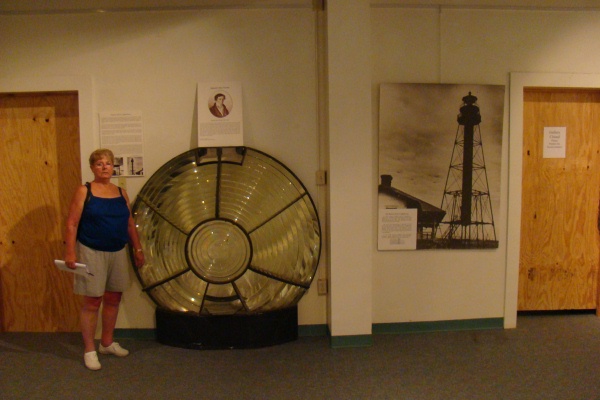 Next stop was to photograph the Galveston Jetty Lantern Room located on the campus of Galveston College. Rescued from the wreck of the Galveston Jetty Lighthouse, it was dedicated in November of 2006 as part of Beacon square, a new “front door” for Galveston College whose vision is “A Beacon of Light Guiding Lifelong Learning.” 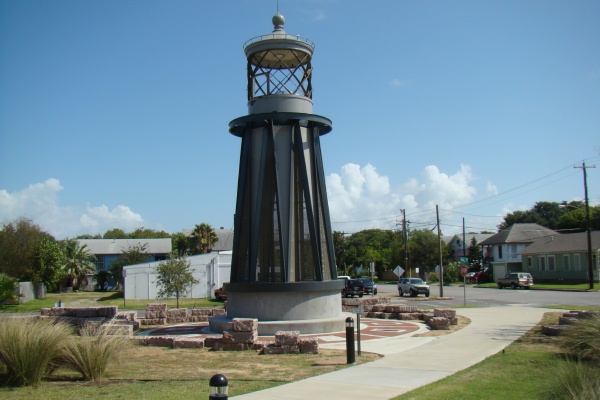
|
|
|
|
Entire Thread
|

 24 lighthouses, 4 lantern rooms, 6,271 miles, $1,011 for gas, 16 day
24 lighthouses, 4 lantern rooms, 6,271 miles, $1,011 for gas, 16 day
|
sandy
|
07/06/08 05:49 AM
|

 Re: 24 lighthouses, 4 lantern rooms, 6,271 miles, $1,011 for gas, 16 day
Re: 24 lighthouses, 4 lantern rooms, 6,271 miles, $1,011 for gas, 16 day
|
sandy
|
07/06/08 05:50 AM
|

 Re: 24 lighthouses, 4 lantern rooms, 6,271 miles, $1,011 for gas, 16 day
Re: 24 lighthouses, 4 lantern rooms, 6,271 miles, $1,011 for gas, 16 day
|
sandy
|
07/06/08 05:50 AM
|

 Re: 24 lighthouses, 4 lantern rooms, 6,271 miles, $1,011 for gas, 16 day
Re: 24 lighthouses, 4 lantern rooms, 6,271 miles, $1,011 for gas, 16 day
|
sandy
|
07/06/08 05:50 AM
|

 Re: 24 lighthouses, 4 lantern rooms, 6,271 miles, $1,011 for gas, 16 day
Re: 24 lighthouses, 4 lantern rooms, 6,271 miles, $1,011 for gas, 16 day
|
sandy
|
07/06/08 05:51 AM
|

 Re: 24 lighthouses, 4 lantern rooms, 6,271 miles, $1,011 for gas, 16 day
Re: 24 lighthouses, 4 lantern rooms, 6,271 miles, $1,011 for gas, 16 day
|
sandy
|
07/06/08 05:51 AM
|

 Re: 24 lighthouses, 4 lantern rooms, 6,271 miles, $1,011 for gas, 16 day
Re: 24 lighthouses, 4 lantern rooms, 6,271 miles, $1,011 for gas, 16 day
|
sandy
|
07/06/08 05:52 AM
|

 Re: 24 lighthouses, 4 lantern rooms, 6,271 miles, $1,011 for gas, 16 day
Re: 24 lighthouses, 4 lantern rooms, 6,271 miles, $1,011 for gas, 16 day
|
MtnHkr
|
07/06/08 02:29 PM
|

 Re: 24 lighthouses, 4 lantern rooms, 6,271 miles, $1,011 for gas, 16 day
Re: 24 lighthouses, 4 lantern rooms, 6,271 miles, $1,011 for gas, 16 day
|
Lighthouse Loon
|
07/06/08 05:08 PM
|

 Re: 24 lighthouses, 4 lantern rooms, 6,271 miles, $1,011 for gas, 16 day
Re: 24 lighthouses, 4 lantern rooms, 6,271 miles, $1,011 for gas, 16 day
|
Bill and Judy
|
07/06/08 10:06 PM
|

 Re: 24 lighthouses, 4 lantern rooms, 6,271 miles, $1,011 for gas, 16 day
Re: 24 lighthouses, 4 lantern rooms, 6,271 miles, $1,011 for gas, 16 day
|
Dave H
|
07/07/08 04:49 PM
|

 Re: 24 lighthouses, 4 lantern rooms, 6,271 miles, $1,011 for gas, 16 day
Re: 24 lighthouses, 4 lantern rooms, 6,271 miles, $1,011 for gas, 16 day
|
kikigl
|
07/08/08 08:38 PM
|

 Re: 24 lighthouses, 4 lantern rooms, 6,271 miles, $1,011 for gas, 16 day
Re: 24 lighthouses, 4 lantern rooms, 6,271 miles, $1,011 for gas, 16 day
|
Bob Taylor
|
07/09/08 02:00 PM
|

 Re: 24 lighthouses, 4 lantern rooms, 6,271 miles, $1,011 for gas, 16 day
Re: 24 lighthouses, 4 lantern rooms, 6,271 miles, $1,011 for gas, 16 day
|
sandy
|
07/09/08 02:20 PM
|

 Re: 24 lighthouses, 4 lantern rooms, 6,271 miles, $1,011 for gas, 16 day
Re: 24 lighthouses, 4 lantern rooms, 6,271 miles, $1,011 for gas, 16 day
|
wheland
|
07/09/08 03:34 PM
|

 Re: 24 lighthouses, 4 lantern rooms, 6,271 miles, $1,011 for gas, 16 day
Re: 24 lighthouses, 4 lantern rooms, 6,271 miles, $1,011 for gas, 16 day
|
Tybee_Sullivan
|
07/10/08 09:42 PM
|
|
|
|
Forums39
Topics16,980
Posts184,642
Members2,583
| |
Most Online10,155
Jan 14th, 2020
|
|
|
1 registered members (Rock),
1,825
guests, and 1
spider. |
|
Key:
Admin,
Global Mod,
Mod
|
|
|

